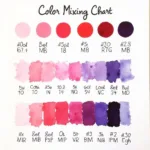Understanding what do the different scrub colors mean can offer fascinating insights into the medical world. Scrubs are more than just comfortable clothing; they are a powerful form of non-verbal communication, subtly conveying roles, departments, and even the emotional tone of a healthcare setting. Let’s delve into the colorful world of scrubs and uncover the hidden meanings behind those various hues.
Decoding the Rainbow: What Do Different Scrub Colors Mean?
Scrub colors can vary significantly between hospitals and even within different departments of the same facility. However, some common color associations have emerged over time. For instance, ceil blue, often linked to pediatrics, aims to create a calming and reassuring atmosphere for young patients. Navy blue, a popular choice for many nurses, projects professionalism and authority. You might be surprised to learn that the choice of scrub color can be as important as understanding what color of scrubs do nurses wear.
The Psychology of Scrub Colors
Why do hospitals choose specific scrub colors? Color psychology plays a significant role. Green, for example, is often favored in operating rooms as it is believed to reduce eye fatigue and offer a visual break from the intensity of red. It’s also thought to minimize the after-image effect of staring at red for extended periods. Burgundy and other darker shades are often associated with more serious or specialized units, potentially reflecting the gravity of the cases they handle.
Common Scrub Colors and Their Meanings
- Ceil Blue: Pediatrics, labor and delivery, and sometimes psychiatry. Intended to evoke feelings of calmness and trust.
- Navy Blue: Nursing, general practice, and surgery. Projects a sense of professionalism and competence.
- Green: Surgery, operating room, and emergency room. Believed to reduce eye strain and create a calming effect.
- Burgundy: Surgery, cardiology, and sometimes ICU. Can suggest seriousness and expertise.
- Black: Often seen in operating rooms, veterinary clinics, and some technical departments. Can be associated with sophistication and precision.
It’s worth noting that these are just common associations and can vary. To understand the specific meaning of scrub colors in a particular healthcare setting, it’s always best to inquire with the facility directly. Want to know more about general scrub color guidelines? Check out can nurses wear any color scrubs.
What do different scrub colors mean in your hospital?
The meaning of scrub colors can vary greatly from one institution to another. Always check with your specific hospital or clinic for their guidelines.
“The choice of scrub color is a deliberate decision, often made to create a specific atmosphere within a medical setting,” says Dr. Amelia Carter, a leading expert in healthcare design. “It’s a subtle yet impactful way to influence both patient and staff perception.”
Beyond the Basics: Specialized Scrub Colors
Some hospitals use less common scrub colors for specific departments or roles. For instance, brown or beige might be seen in physical therapy, while pink or lavender might be used in oncology or palliative care. These choices often reflect a desire to create a more comforting and supportive environment. Understanding these nuances adds another layer to knowing what do the different scrub colors mean. The question what do different scrub colors mean is more complex than you might initially think.
How are scrub colors chosen?
Often, the decision of what scrub colors to use is made by hospital administration, taking into account factors such as department function, patient demographics, and even brand identity. This demonstrates the careful consideration given to color in the healthcare context.
“Color can have a profound psychological effect on both patients and medical staff,” notes Professor Michael Reed, a specialist in color psychology. “Choosing the right colors can contribute to a more positive and healing environment.”
What do the Different Scrub Colors Mean: Conclusion
Understanding what do the different scrub colors mean offers a glimpse into the intricate world of healthcare communication. While there are some commonly accepted associations, the specific meaning of scrub colors can vary. It’s always best to check with the specific institution for clarification. Knowing these color codes allows us to appreciate the thoughtfulness and intention behind the seemingly simple choice of scrub color. Want to learn more about how colors affect us? You might be interested in how they impact other materials, such as in our article about does food coloring stain porcelain. Another intriguing color application in medicine can be found in our exploration of what are the red and blue colors on an ultrasound.
FAQ
- Do scrub colors always mean the same thing in every hospital? No, they can vary.
- Why are green scrubs common in surgery? They can reduce eye strain and offer a calming effect.
- Who decides what color scrubs are worn? Typically, hospital administration.
- Can nurses wear any color scrubs they want? Not usually, there are often hospital guidelines.
- What color scrubs are commonly worn in pediatrics? Ceil blue.
- Are there other factors that determine scrub color besides department? Yes, things like patient demographics and hospital branding can also play a role.
- What do dark-colored scrubs typically signify? They can be associated with more specialized or serious units.
For further assistance, please contact us:
Phone: 0373298888
Email: [email protected]
Address: 86 Cầu Giấy, Hà Nội.
We have a 24/7 customer service team.
